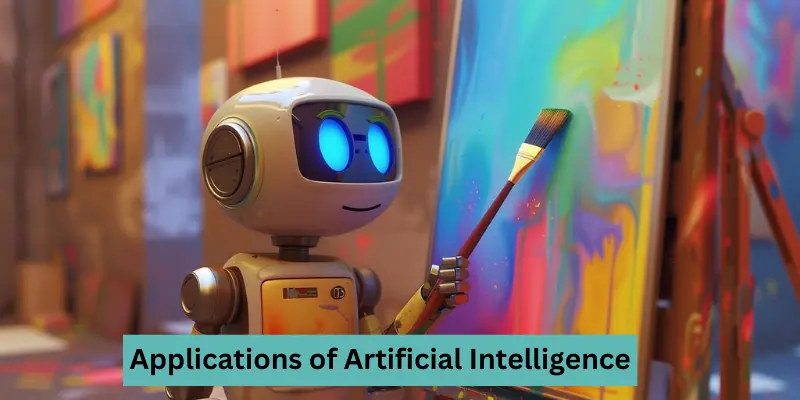What is Artificial Intelligence and How is it Used?
Published: 01 Jan 2025
Artificial Intelligence (AI) is no longer a futuristic concept confined to science fiction; it has become a transformative force across industries and daily life.
From improving business efficiency to personalizing user experiences, AI is reshaping the world. In this article, we will explore what artificial intelligence is, how it works, and its many uses in various fields. What is Artificial Intelligence and How is it Used?

What is Artificial Intelligence?
Artificial Intelligence refers to the simulation of human intelligence in machines programmed to think, learn, and make decisions. These machines mimic cognitive functions such as problem-solving, learning from data, and understanding natural language. AI systems aim to automate tasks that typically require human intelligence, ranging from simple activities like voice recognition to complex problem-solving in industries like healthcare and finance. challenges of AI
The Types of AI
AI can be categorized into three main types:
- Narrow AI: This is task-specific AI designed to perform a single function, such as voice assistants (e.g., Siri, Alexa) or recommendation algorithms on platforms like Netflix.
- General AI: This is a theoretical concept where AI can perform any intellectual task a human can. General AI is not yet fully developed but remains a significant area of research.
- Superintelligent AI: Refers to AI that surpasses human intelligence. While still a concept in science fiction, it raises important ethical considerations for the future. Artificial Intelligence
How Does Artificial Intelligence Work?
Artificial Intelligence functions through the combination of data, algorithms, and computational power. At its core, AI systems are designed to analyze input data, learn from patterns, and make decisions or predictions based on that data. Here’s a detailed breakdown of how AI works:
Data Collection and Preprocessing
AI systems rely on large volumes of data to function effectively. This data can come from various sources such as text, images, videos, or real-time sensor inputs. The data is then cleaned and preprocessed to ensure it is accurate and free of inconsistencies. For example: advantages & disadvantages of AI
Structured Data: Data organized in rows and columns, such as databases or spreadsheets.
Unstructured Data: Data like social media posts, videos, or emails, which require more advanced processing.
Algorithm Selection
The core of any AI system lies in the algorithm it uses. Algorithms are mathematical models that define how the system will process data and learn from it. Common algorithms include:
Regression Algorithms: Used for predicting continuous values, such as stock prices or temperature trends.
Classification Algorithms: Help categorize data, such as identifying spam emails or classifying images of cats and dogs.
Clustering Algorithms: Group similar data points together, often used in customer segmentation.
Natural Language Processing (NLP)
NLP allows machines to understand and generate human language. This technology is used in chatbots, translation services, and virtual assistants like Google Assistant. How Technology is Changing
Computer Vision
Computer Vision enables AI systems to interpret visual data from the world, such as images and videos. Applications include medical imaging diagnostics and automated quality checks in manufacturing.
Applications of Artificial Intelligence

AI has countless applications across industries, transforming the way businesses operate and enhancing everyday life. Here are some of the most prominent examples:
.1 Healthcare
Diagnostics: AI-powered tools analyze medical images, such as X-rays and MRIs, to detect diseases like cancer at early stages with high accuracy.
Personalized Treatment: AI systems analyze patient data to suggest customized treatment plans tailored to individual needs.
Drug Discovery: AI accelerates the discovery of new drugs by analyzing biological data and predicting the effectiveness of compounds.
Robotic Surgery: AI-powered robots assist surgeons in performing precise and minimally invasive procedures. Machine Learning Explained
.2 Finance
Fraud Detection: AI systems monitor transactions in real-time, identifying unusual patterns that could indicate fraud.
Risk Assessment: AI evaluates creditworthiness and financial risks by analyzing historical data and predicting potential outcomes.
Algorithmic Trading: AI systems execute trades based on market data analysis, optimizing investment strategies and maximizing returns.
Customer Support: AI chatbots handle customer inquiries, providing instant assistance and improving user experience.
.3 Transportation
Autonomous Vehicles: Self-driving cars use AI to interpret traffic signals, detect obstacles, and navigate complex road systems.
Traffic Management: AI optimizes traffic flow by analyzing data from sensors and cameras, reducing congestion in urban areas.
Predictive Maintenance: AI monitors vehicle performance to predict and prevent mechanical failures, enhancing safety and reliability.
.4 Retail
Personalized Shopping: AI analyzes customer preferences and shopping behavior to recommend products, creating a tailored shopping experience.
Inventory Management: AI predicts demand trends, ensuring optimal stock levels and reducing waste.
Visual Search: AI enables customers to search for products using images, enhancing the e-commerce experience.
Chatbots: AI-powered virtual assistants provide instant responses to customer queries, improving satisfaction.
.5 Education
Personalized Learning: AI tailors educational content to individual learning styles and paces, helping students achieve better outcomes.
Administrative Automation: AI handles tasks such as scheduling, grading, and managing enrollments, freeing up educators’ time.
Virtual Tutors: AI-powered tutoring systems provide one-on-one assistance to students, helping them understand complex concepts.
Content Creation: AI helps generate quizzes, assignments, and learning materials, enhancing the teaching process.
.6 Entertainment
Content Recommendations: AI analyzes user preferences to suggest movies, shows, or music, providing a personalized entertainment experience.
Game Development: AI creates adaptive and realistic gaming environments, enhancing player engagement.
Automated Video Editing: AI tools streamline video editing processes, allowing creators to produce high-quality content efficiently.
Creative Assistance: AI generates scripts, music, and visual effects, aiding artists and creators in their projects.
.7 Agriculture
Precision Farming: AI uses sensors and data analytics to monitor soil health, weather conditions, and crop performance, improving yields.
Pest Control: AI-powered drones identify and target pest infestations, reducing the need for chemical pesticides.
Irrigation Optimization: AI analyzes data to optimize water usage, ensuring sustainable farming practices.
Harvest Prediction: AI predicts optimal harvest times, reducing waste and maximizing profits.
Benefits of Artificial Intelligence
Artificial Intelligence offers numerous advantages that are transforming industries and daily life. Here are some key benefits of AI explained in detail:
1 Efficiency
AI automates repetitive and time-consuming tasks, freeing up human resources to focus on more complex and creative responsibilities. For example:
Customer Service: AI chatbots can handle thousands of customer inquiries simultaneously, providing 24/7 support and reducing wait times.
Manufacturing: AI-driven robotics optimize production lines, ensuring consistent quality and faster outputs.
2 Accuracy
AI systems excel in processing large datasets and making precise calculations, minimizing the likelihood of human error. For instance:
Healthcare: AI-powered diagnostic tools analyze medical images with high accuracy, enabling early detection of diseases like cancer.
Finance: AI detects anomalies in financial transactions, reducing the risk of fraud.
3 Personalization
AI enhances user experiences by delivering personalized content and recommendations based on individual preferences. Examples include:
Streaming Services: Platforms like Netflix and Spotify use AI algorithms to suggest movies, shows, and songs tailored to users’ tastes.
E-commerce: AI recommends products based on browsing history, increasing customer satisfaction and sales.
4 Scalability
AI enables businesses to scale their operations seamlessly. By automating processes, organizations can handle increased workloads without compromising efficiency. Examples include:
Supply Chain Management: AI predicts demand trends, ensuring optimal inventory levels during peak seasons.
Data Analysis: AI systems process and analyze vast amounts of data in real-time, helping businesses make informed decisions.
5 Cost Savings
By streamlining operations and reducing human intervention, AI helps organizations cut costs while maintaining high productivity. For example:
Energy Management: AI optimizes energy usage in buildings, reducing utility expenses.
Human Resources: AI automates resume screening and initial interviews, saving time and recruitment costs.
6 Innovation
AI drives innovation by enabling the development of new technologies and solutions. Examples include:
Autonomous Vehicles: Self-driving cars rely on AI to navigate roads and ensure passenger safety.
Smart Cities: AI systems manage urban resources like traffic flow and energy distribution efficiently.
Challenges and Ethical Considerations
While AI offers immense potential, it also raises significant challenges and ethical questions:
Job Displacement
As automation increases, certain jobs may become obsolete. Industries must focus on reskilling workers to adapt to new roles created by AI.
Bias in AI Systems
AI systems can inherit biases from the data they are trained on, leading to unfair outcomes. For instance, biased hiring algorithms may disadvantage certain demographic groups.
Privacy Concerns
AI systems often rely on large datasets, which may include sensitive personal information. Ensuring data privacy and security is crucial to maintaining user trust.
Ethical AI Development
Governments and organizations must establish guidelines to ensure AI development aligns with ethical principles, such as transparency, accountability, and fairness.
Introduction:
“Test your knowledge about Artificial Intelligence (AI)! This quick quiz will challenge your understanding of what AI is, how it works, and its fascinating applications in our everyday lives. Are you ready to discover how much you really know about AI?”
Questions:
- What does Artificial Intelligence aim to simulate?
- A) Human Emotions
- B) Human Intelligence
- C) Human Physical Strength
- D) None of the Above
(Answer: B) Human Intelligence
- Which type of AI is task-specific and designed for a single function?
- A) General AI
- B) Narrow AI
- C) Superintelligent AI
- D) Cognitive AI
(Answer: B) Narrow AI
- What is a common application of Natural Language Processing (NLP)?
- A) Diagnosing Diseases
- B) Facial Recognition
- C) Language Translation
- D) Controlling Robots
(Answer: C) Language Translation
- Which industry commonly uses AI for fraud detection?
- A) Transportation
- B) Finance
- C) Retail
- D) Healthcare
(Answer: B) Finance
- What is the primary goal of reinforcement learning in AI?
- A) Predict future trends
- B) Improve through rewards and penalties
- C) Recognize patterns in data
- D) Translate languages
(Answer: B) Improve through rewards and penalties
- How does AI improve accessibility for people with disabilities?
- A) By controlling physical devices
- B) Through voice assistants and real-time translations
- C) By enhancing sensory abilities
- D) By automating workflows
(Answer: B) Through voice assistants and real-time translations
- Which of the following is an example of computer vision?
- A) Chatbots answering customer queries
- B) A self-driving car detecting pedestrians
- C) An AI system suggesting movies
- D) Predicting weather patterns
(Answer: B) A self-driving car detecting pedestrians
- What is model retraining in AI?
- A) Adjusting hardware configurations
- B) Replacing algorithms with new ones
- C) Continuously learning from new data
- D) Testing AI models in real environments
(Answer: C) Continuously learning from new data
Scoring:
- 6-8 Correct: You’re an AI expert in the making!
- 3-5 Correct: You have a good grasp of AI concepts.
- 0-2 Correct: Time to learn more about the amazing world of AI!
Call-to-Action:
“Share your results and challenge your friends to see who knows more about Artificial Intelligence!”
The Future of Artificial Intelligence
AI continues to evolve, with emerging trends shaping its future:
Human-AI Collaboration
The future of AI lies in collaboration between humans and machines. AI systems will enhance human capabilities rather than replace them entirely.
Quantum Computing
Quantum computing promises to revolutionize AI by enabling faster data processing and solving complex problems that traditional computers cannot handle.
AI in Sustainability
AI will play a critical role in addressing global challenges like climate change by optimizing resource usage and reducing waste.
Conclusion
Artificial Intelligence is a transformative technology with the potential to improve lives and drive progress across industries. By understanding what AI is and how it works, we can better appreciate its applications and address the challenges it presents. As AI continues to evolve, its impact on society will only grow, making it essential to harness its potential responsibly and ethically.
Answer:
Artificial Intelligence (AI) is the overarching concept of machines mimicking human intelligence to perform tasks. Machine Learning (ML), on the other hand, is a subset of AI that enables systems to learn and improve from data without explicit programming. While AI focuses on broader functionalities like decision-making and problem-solving, ML specifically deals with data-driven learning to make predictions or classifications.
Bias in Algorithms: AI systems can inherit biases from their training data, leading to unfair outcomes.
Job Displacement: Automation of tasks may result in reduced employment opportunities in certain sectors.
Privacy Concerns: The reliance on vast amounts of data can raise issues regarding data security and user privacy.
Ethical Use: There is a growing need for guidelines to ensure AI development aligns with ethical principles, such as transparency and fairness.
Proudly powered by WordPress






